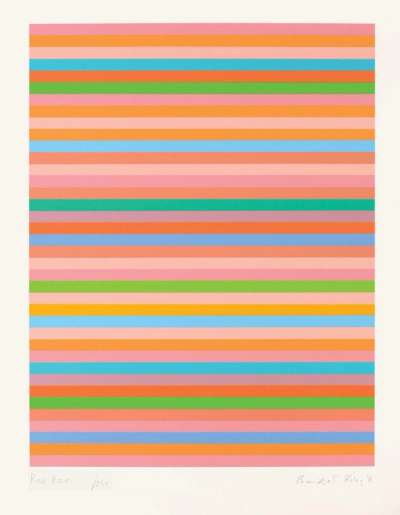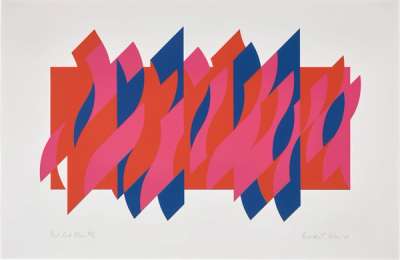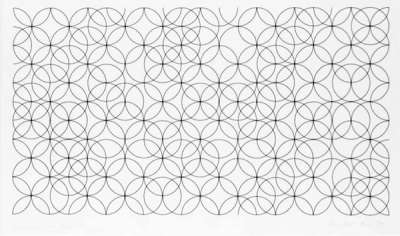Bridget Riley's Inspirations: From Seurat to the Present

 Rothko Portfolio © Bridget Riley 1973
Rothko Portfolio © Bridget Riley 1973
Bridget Riley
106 works
Bridget Riley stands as a towering figure in contemporary art, renowned for her captivating optical illusions that challenge and enthral viewers. Her work, characterised by dynamic patterns, vibrant contrasts, and an innate sense of rhythm, anchors her as a pivotal force in the Op Art movement. Central to understanding Riley’s journey is her foundational inspiration — Georges Seurat, the French Post-Impressionist known for his innovative dot technique. Riley's transition from Seurat’s influence to her distinct contributions to Op Art marks a fascinating evolution, reflecting a deep engagement with visual perception and the psychological impact of art.
The Foundations of Bridget Riley's Art
Seurat’s meticulous approach to Pointillism, where small, distinct dots of colour are applied in patterns to form an image, sparked Riley's interest in the mechanics of visual perception. Seurat’s principles of colour theory and his methodical exploration of optical effects provided a rich foundation for Riley. She was particularly drawn to his use of contrasting colours and the way they interacted to enhance luminosity and depth, creating a vibrating effect on the canvas.
Riley’s engagement with these principles was not merely imitative but deeply analytical. She studied how Seurat’s dot technique could be evolved or abstracted to further investigate the relationship between colour, light, and form. This exploration was pivotal in Riley's art, laying the groundwork for her subsequent experimentation with visual perception. Seurat’s influence on Riley extended beyond his techniques to encompass his rigorous scientific approach to art, encouraging her to delve into the psychological effects of optical phenomena.
Bridget Riley’s Transition to Op Art
The transition from Seurat-inspired pointillism to the development of her signature Op Art style was a critical phase in Riley’s career. Moving away from the representational focus of Post-Impressionism, Riley began to experiment with geometric patterns and abstract designs that played directly on the viewer’s visual perceptions. Her early work in the 1960s, such as Movement In Squares and Fall, marked a significant departure from traditional forms of painting, embracing a new visual language that was entirely her own.
These key works highlight the evolution of Riley’s artistic approach and technique. Movement In Squares consists of a series of black and white squares that create a sensation of movement and depth, challenging the static nature of the canvas. Fall, on the other hand, employs a curvilinear design to evoke a sense of disorientation and vertigo in the viewer. Both pieces underscore Riley’s fascination with the dynamics of sight and her ability to transform flat surfaces into vivid, interactive experiences. Riley’s shift to Op Art was a conceptual revolution. She embraced abstraction as a means to explore the fundamental processes of visual perception, drawing on the legacy of Seurat but extending it into a new reach. This phase of Riley’s career solidified her position as a leading figure in the Op Art movement, renowned for her ability to create artworks that exist in a dynamic relationship with the observer.
Bridget Riley's Key Influences and Visual Language
While Seurat's influence on Riley is well-documented, her artistic development was also shaped by a broader constellation of figures and movements within the 20th-century visual art landscape. One influence was Hungarian-French artist Victor Vasarely, known as a key progenitor of Op Art. Vasarely's geometric abstraction, with its focus on creating depth and movement through precise, mathematical arrangements of shapes and colours, resonated with Riley. Vasarely's exploration of optical effects and visual kinetics provided Riley with a framework to expand her own investigations into perception and illusion.
Riley's work, however, diverges from Vasarely's in her unique application and interpretation of optical phenomena. Where Vasarely often employed a more rigid, grid-like structure to achieve his optical effects, Riley sought a more fluid expression, drawing inspiration from the natural world and the subjective experience of sight. This distinction underscores the dynamic exchange of ideas among artists within the Op Art movement, as they each navigated the balance between scientific accuracy and artistic expression.
The dialogue between Riley and her contemporaries was not limited to those within the Op Art movement. Her work is part of a broader discourse on abstraction that includes influences from movements such as Abstract Expressionism, Minimalism, and the Bauhaus school, reflecting a rich interplay of ideas on form, colour, and the role of the viewer. Riley’s ability to synthesise these varied influences while pursuing her own distinct path illustrates the complex network of artistic interlocutors that have shaped the development of 20th-century art.
Riley's fascination with the mechanics of sight drew her to the research of Hermann von Helmholtz, a pioneer in understanding vision's psychological dimensions. Helmholtz's insights into the brain's holistic processing of visual stimuli resonate in Riley's art, which masterfully employs patterns and repetition to craft immersive optical experiences. This approach underscores the intricate relationship between visual perception and the emotional responses elicited by her dynamic compositions.
Bridget Riley's Technological and Scientific Inspirations
Riley's oeuvre is deeply intertwined with the advancements in scientific research and technology, especially those related to visual perception and optical illusions. Her work reflects a profound engagement with scientific theories of sight and the mechanics of the human eye, drawing upon the studies of vision scientists and psychologists to deepen her exploration of optical phenomena. This scientific underpinning is evident in Riley’s methodical approach to composition, where she applies principles of contrast, vibration, and movement to elicit specific visual responses from the viewer.
Riley’s science of seeing serves as an investigation into the ways technological and scientific advancements can alter and enhance the visual experience. By incorporating insights from fields such as Gestalt psychology, which examines the human tendency to perceive visual elements as organised patterns, Riley’s compositions invite viewers to engage in a participatory experience, challenging their perceptions and highlighting the subjective nature of sight.
This fusion of art with science has not only informed Riley's methodology but has also significantly influenced the reception of her work, positioning her as a pioneer in the dialogue between the two disciplines. The technological and scientific inspirations behind her art have facilitated a deeper understanding of visual perception, both within the art world and beyond, contributing to the enduring fascination with her work.
The Cultural and Historical Contexts of Bridget Riley's Art
The evolution of Riley's art cannot be fully appreciated without considering the cultural and historical contexts that have shaped her artistic journey. Growing up in post-war Britain, Riley was part of a society undergoing rapid transformation, marked by social upheaval, technological innovation, and a redefinition of national identity. The austerity and recovery of the post-war era, coupled with the burgeoning optimism of the 1960s, provided a backdrop against which Riley explored new artistic directions.
This period was characterised by a questioning of traditional values and a fervent exploration of new forms of expression, both of which found echoes in Riley's work. Her move towards abstraction and the Op Art movement can be seen as part of a broader cultural shift towards experimentation and innovation. The social and political climate of the time, with its emphasis on progress and modernity, mirrored Riley's own pursuit of a new visual language that could encapsulate the dynamism and complexity of the contemporary world.
The themes and execution of Riley’s work are also reflective of the broader narrative of her career, which has been marked by a continuous engagement with the changing cultural and historical landscape. Her ability to synthesise the influences of her time — ranging from the scientific to the social — into a coherent artistic vision is a testament to her sensitivity to the cultural currents that have swirled around her.
Bridget Riley's Impact on Contemporary Art
Riley’s impact on contemporary art and her legacy within the Op Art movement underscore her status as one of the most influential artists of the 20th and 21st centuries. Riley’s exploration of visual perception, through meticulously crafted patterns and colours, has not only defined the Op Art movement but has also offered a new lens through which to understand the relationship between art, emotion, and the viewer. Her work has inspired subsequent generations of artists to explore the possibilities of visual perception in their practices, pushing the boundaries of how art can interact with and alter the viewer's experience.
Riley's contributions to discussions on visual perception have been groundbreaking, integrating insights from psychology, physics, and biology to investigate how visual stimuli are processed and interpreted. Her exploration of the emotional impact of art has challenged traditional narratives about the role of abstraction, demonstrating how non-representational forms can generate heightened emotional responses. Riley’s work has played a crucial role in redefining the dynamic between art and viewer, positioning the viewer not as a passive recipient but as an active participant in the creation of meaning.
Her legacy extends beyond her contributions to the Op Art movement, influencing fields such as design, architecture, and even fashion. Riley’s insistence on the primacy of the viewer’s experience has informed contemporary discussions about the interactive and immersive possibilities of art, making her work a critical point of reference for artists, curators, and scholars alike.
Bridget Riley Today: Ongoing Inspirations and Evolving Practice
Even in the current phase of her work, Riley continues to evolve, drawing inspiration from a myriad of sources and relentlessly pursuing new avenues of exploration. Recent projects and exhibitions showcase her unflagging commitment to innovation and her ability to adapt her approach in response to both aesthetic and technological advancements. Riley’s recent works delve deeper into the complexities of colour interaction, spatial dynamics, and the modulation of form, reflecting an ongoing engagement with the principles that have defined her career while also venturing into new conceptual territories.
Riley's capacity to draw inspiration from diverse sources — from the natural world to the latest developments in visual science — ensures that her practice remains vibrant and relevant. Her recent exhibitions have been characterised by a continual refinement of her visual language, with each series of works presenting a fresh investigation into the possibilities of optical and perceptual art. These exhibitions not only highlight Riley's enduring influence but also her ability to remain at the forefront of contemporary art, challenging and captivating new audiences.
Even at the age of 92, Riley has continued to embark on an exciting new endeavour, creating her inaugural ceiling installation for the British School in Rome. This work showcases her iconic stripes, now presented with a curved aesthetic, set against a backdrop of her signature blue hues, complemented by lines in red, white, orange, and lilac. Drawing inspiration from the Sistine Chapel's ceiling by Michelangelo, Riley has crafted a distinctive piece that perfectly combines the historical charm of classical art with her unique approach to optical illusions. This project highlights Riley's unwavering commitment to innovation, seamlessly weaving together the threads of tradition and modern artistic expression, and pushing the boundaries of how stories are visually conveyed.
The evolution of Riley’s practice speaks to her deep intellectual curiosity and her unwavering dedication to exploring the fundamental questions of sight and perception. As she adapts and responds to new challenges, Riley’s work continues to inspire fresh possibilities for the field of visual art, reaffirming her role as a pivotal figure whose contributions extend far beyond the Op Art movement. Through her ongoing inspirations and evolving practice, Riley demonstrates that the quest for understanding the complexities of visual perception and the emotional capacities of abstract art is a continually unfolding journey, offering endless opportunities for discovery and innovation.





















